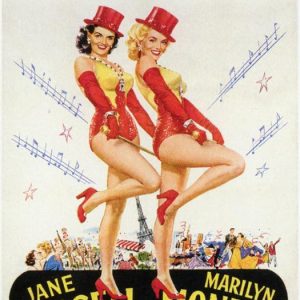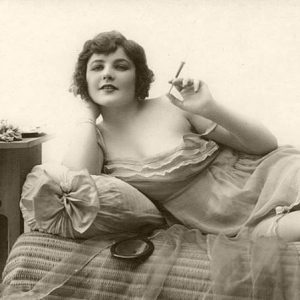calsfoundation@cals.org
Lorelei Lee
Fictional Character
The fictional character of Lorelei Lee, who calls herself the “little girl from Little Rock,” was created by writer Anita Loos (1889–1981). Lorelei first appeared as a character in short stories, followed by the bestselling novel Gentlemen Prefer Blondes, several successful Broadway shows, and a hit movie. The Lorelei Lee character is closely identified with her fictitious home of Little Rock (Pulaski County) in the state of Arkansas.
After emerging in a series of short sketches published in Harper’s Bazaar during the early 1920s, what became known as the “Lorelei” stories were so popular that they tripled the magazine’s circulation. After Loos was encouraged by friends in the publishing business to adapt the stories into a book, her bestselling comedic novel Gentlemen Prefer Blondes: The Intimate Diary of a Professional Lady was published in 1925 to great acclaim. A sequel that followed Lorelei’s later adventures, But Gentlemen Marry Brunettes, was published two years later.
In response to a male friend’s suggestion about writing down her thoughts in a book, the character of Lorelei (the blonde of the Gentlemen Prefer Blondes book title) narrates the novel in the form of a diary, complete with misspellings and grammatical errors. At first, the character was named “Mabel Minnow” and attended business school in Little Rock at her father’s insistence. A series of misunderstandings and misadventures leads her to stand trial for murder, although she is acquitted by an all-male jury. The judge gives her the name Lorelei Lee, which he felt better suited her personality, and buys her a ticket to Hollywood. In the book, Lorelei’s philosophy of life is, “Smile, smile, smile.”
In a 1963 re-issue of Gentlemen Prefer Blondes, Loos includes an introduction called “The Biography of a Book.” She states that she was inspired to create the character of Lorelei after seeing a usually serious male friend react gushingly to a beautiful blond-haired woman. The friend in question was journalist Henry Louis “H. L.” Mencken (1880–1956). Known nationally as the “Sage of Baltimore,” he commented acerbically on American culture, politics, and current events in his writings. In the 1920s, Mencken often attacked the South in general as a “booboisie” (referring to the word “bourgeoisie”), full of “Ku Kluxery,” “Bible Belt barbarism,” and “poor white trash.” He referred to Arkansas by stating that the state’s residents were “too stupid to see what was the matter with them.” When Arkansans complained, Mencken responded, “I didn’t make Arkansas the butt of ridicule—God did.”
In her introduction to the 1963 edition of Gentlemen Prefer Blondes, Loos reveals why she made Lorelei a native of Arkansas: “I wanted Lorelei to be a symbol of our nation’s lowest possible mentality and remembered Mencken’s essay on American culture in which he branded the state of Arkansas as ‘the Sahara of the Bozarts.’ I therefore chose Little Rock for Lorelei’s early years; Little Rock, which even today lives up to Mencken’s choice as a nadir in shortsighted human stupidity.” (“Bozarts” refers to beaux arts, or fine arts.) Lorelei writes that she was “just a little girl from Little Rock” but came from “a very very good family because papa was very intelectual [sic], and he was a very very prominent Elk…”
In 1926, Lorelei and other characters from the book were portrayed in a syndicated daily newspaper comic strip series that ran for about five months. That same year, Gentlemen Prefer Blondes was adapted for the Broadway stage. The production ran for about six months and starred veteran Broadway actress June Walker as Lorelei. In 1928, the book was adapted into a silent film, now presumed lost, that starred Ruth Taylor in the role of Lorelei Lee.
The character of Lorelei appeared on Broadway again in the 1949 Broadway musical Gentlemen Prefer Blondes starring Carol Channing, and once again in the 1974 Broadway production of the show that was re-titled Lorelei, again starring Carol Channing.
A hit film adaptation came in 1953 with Gentlemen Prefer Blondes, featuring Marilyn Monroe as Lorelei Lee. The film, which made Monroe a star, offers probably the most iconic portrayal of the character. Lorelei’s philosophy is summed up onscreen in a song featured in the film: “Diamonds Are a Girl’s Best Friend.”
For additional information:
Carey, Gary. Anita Loos. New York: Knopf, 1988.
De Roche, Linda. The Jazz Age: A Historical Exploration of Literature. Santa Barbara, CA: Greenwood, 2015.
Hammill, Faye. Women, Celebrity, and Literary Culture between the Wars. Austin: University of Texas Press, 2010.
Kort, Carol. A to Z of American Women Writers. New York: Facts on File Library of American History, 2007.
Loos, Anita. “The Biography of a Book.” In Gentlemen Prefer Blondes. New York: Liveright, 1963.
Loos, Anita, and Ray Pierre Corsini, eds. Fate Keeps on Happening: Adventures of Lorelei Lee and Other Writings. New York: Dodd Mead, 1984.
Rodgers, Marion Elizabeth. Mencken: The American Iconoclast. New York: Oxford University Press, 2005.
Nancy Hendricks
Garland County Historical Society
 Arkansas's Image
Arkansas's Image Literature and Authors
Literature and Authors Gentlemen Prefer Blondes
Gentlemen Prefer Blondes  Gentlemen Prefer Blondes Movie
Gentlemen Prefer Blondes Movie  Anita Loos
Anita Loos 



Comments
No comments on this entry yet.